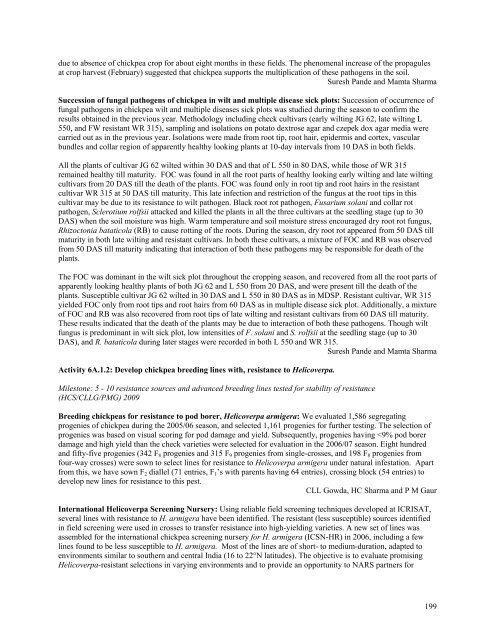ICRISAT Archival Report 2006 - The seedlings of success in the ...
ICRISAT Archival Report 2006 - The seedlings of success in the ...
ICRISAT Archival Report 2006 - The seedlings of success in the ...
Create successful ePaper yourself
Turn your PDF publications into a flip-book with our unique Google optimized e-Paper software.
due to absence <strong>of</strong> chickpea crop for about eight months <strong>in</strong> <strong>the</strong>se fields. <strong>The</strong> phenomenal <strong>in</strong>crease <strong>of</strong> <strong>the</strong> propagules<br />
at crop harvest (February) suggested that chickpea supports <strong>the</strong> multiplication <strong>of</strong> <strong>the</strong>se pathogens <strong>in</strong> <strong>the</strong> soil.<br />
Suresh Pande and Mamta Sharma<br />
Succession <strong>of</strong> fungal pathogens <strong>of</strong> chickpea <strong>in</strong> wilt and multiple disease sick plots: Succession <strong>of</strong> occurrence <strong>of</strong><br />
fungal pathogens <strong>in</strong> chickpea wilt and multiple diseases sick plots was studied dur<strong>in</strong>g <strong>the</strong> season to confirm <strong>the</strong><br />
results obta<strong>in</strong>ed <strong>in</strong> <strong>the</strong> previous year. Methodology <strong>in</strong>clud<strong>in</strong>g check cultivars (early wilt<strong>in</strong>g JG 62, late wilt<strong>in</strong>g L<br />
550, and FW resistant WR 315), sampl<strong>in</strong>g and isolations on potato dextrose agar and czepek dox agar media were<br />
carried out as <strong>in</strong> <strong>the</strong> previous year. Isolations were made from root tip, root hair, epidermis and cortex, vascular<br />
bundles and collar region <strong>of</strong> apparently healthy look<strong>in</strong>g plants at 10-day <strong>in</strong>tervals from 10 DAS <strong>in</strong> both fields.<br />
All <strong>the</strong> plants <strong>of</strong> cultivar JG 62 wilted with<strong>in</strong> 30 DAS and that <strong>of</strong> L 550 <strong>in</strong> 80 DAS, while those <strong>of</strong> WR 315<br />
rema<strong>in</strong>ed healthy till maturity. FOC was found <strong>in</strong> all <strong>the</strong> root parts <strong>of</strong> healthy look<strong>in</strong>g early wilt<strong>in</strong>g and late wilt<strong>in</strong>g<br />
cultivars from 20 DAS till <strong>the</strong> death <strong>of</strong> <strong>the</strong> plants. FOC was found only <strong>in</strong> root tip and root hairs <strong>in</strong> <strong>the</strong> resistant<br />
cultivar WR 315 at 50 DAS till maturity. This late <strong>in</strong>fection and restriction <strong>of</strong> <strong>the</strong> fungus at <strong>the</strong> root tips <strong>in</strong> this<br />
cultivar may be due to its resistance to wilt pathogen. Black root rot pathogen, Fusarium solani and collar rot<br />
pathogen, Sclerotium rolfsii attacked and killed <strong>the</strong> plants <strong>in</strong> all <strong>the</strong> three cultivars at <strong>the</strong> seedl<strong>in</strong>g stage (up to 30<br />
DAS) when <strong>the</strong> soil moisture was high. Warm temperature and soil moisture stress encouraged dry root rot fungus,<br />
Rhizoctonia bataticola (RB) to cause rott<strong>in</strong>g <strong>of</strong> <strong>the</strong> roots. Dur<strong>in</strong>g <strong>the</strong> season, dry root rot appeared from 50 DAS till<br />
maturity <strong>in</strong> both late wilt<strong>in</strong>g and resistant cultivars. In both <strong>the</strong>se cultivars, a mixture <strong>of</strong> FOC and RB was observed<br />
from 50 DAS till maturity <strong>in</strong>dicat<strong>in</strong>g that <strong>in</strong>teraction <strong>of</strong> both <strong>the</strong>se pathogens may be responsible for death <strong>of</strong> <strong>the</strong><br />
plants.<br />
<strong>The</strong> FOC was dom<strong>in</strong>ant <strong>in</strong> <strong>the</strong> wilt sick plot throughout <strong>the</strong> cropp<strong>in</strong>g season, and recovered from all <strong>the</strong> root parts <strong>of</strong><br />
apparently look<strong>in</strong>g healthy plants <strong>of</strong> both JG 62 and L 550 from 20 DAS, and were present till <strong>the</strong> death <strong>of</strong> <strong>the</strong><br />
plants. Susceptible cultivar JG 62 wilted <strong>in</strong> 30 DAS and L 550 <strong>in</strong> 80 DAS as <strong>in</strong> MDSP. Resistant cultivar, WR 315<br />
yielded FOC only from root tips and root hairs from 60 DAS as <strong>in</strong> multiple disease sick plot. Additionally, a mixture<br />
<strong>of</strong> FOC and RB was also recovered from root tips <strong>of</strong> late wilt<strong>in</strong>g and resistant cultivars from 60 DAS till maturity.<br />
<strong>The</strong>se results <strong>in</strong>dicated that <strong>the</strong> death <strong>of</strong> <strong>the</strong> plants may be due to <strong>in</strong>teraction <strong>of</strong> both <strong>the</strong>se pathogens. Though wilt<br />
fungus is predom<strong>in</strong>ant <strong>in</strong> wilt sick plot, low <strong>in</strong>tensities <strong>of</strong> F. solani and S. rolfsii at <strong>the</strong> seedl<strong>in</strong>g stage (up to 30<br />
DAS), and R. bataticola dur<strong>in</strong>g later stages were recorded <strong>in</strong> both L 550 and WR 315.<br />
Suresh Pande and Mamta Sharma<br />
Activity 6A.1.2: Develop chickpea breed<strong>in</strong>g l<strong>in</strong>es with, resistance to Helicoverpa.<br />
Milestone: 5 - 10 resistance sources and advanced breed<strong>in</strong>g l<strong>in</strong>es tested for stability <strong>of</strong> resistance<br />
(HCS/CLLG/PMG) 2009<br />
Breed<strong>in</strong>g chickpeas for resistance to pod borer, Helicoverpa armigera: We evaluated 1,586 segregat<strong>in</strong>g<br />
progenies <strong>of</strong> chickpea dur<strong>in</strong>g <strong>the</strong> 2005/06 season, and selected 1,161 progenies for fur<strong>the</strong>r test<strong>in</strong>g. <strong>The</strong> selection <strong>of</strong><br />
progenies was based on visual scor<strong>in</strong>g for pod damage and yield. Subsequently, progenies hav<strong>in</strong>g

















